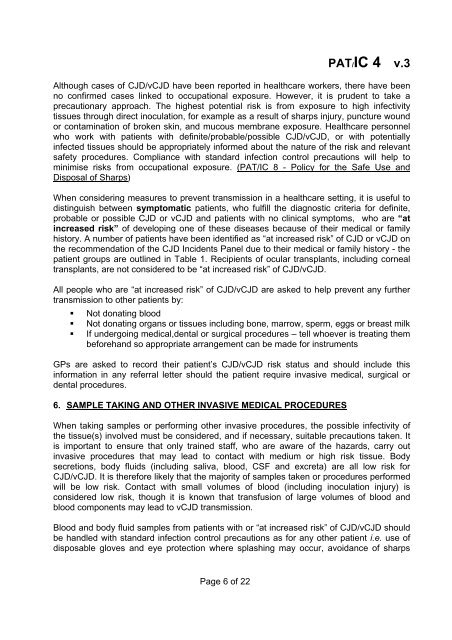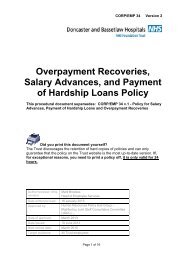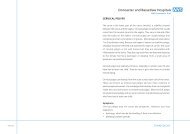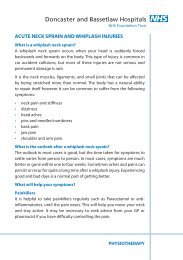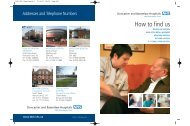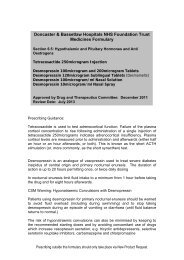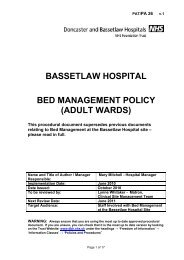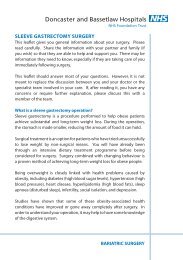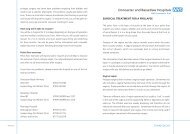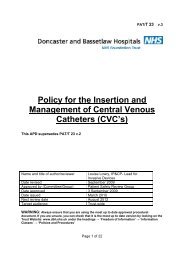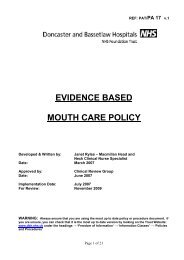VARIANT CREUTZFELDT-JAKOB DISEASE (vCJD) AND ...
VARIANT CREUTZFELDT-JAKOB DISEASE (vCJD) AND ...
VARIANT CREUTZFELDT-JAKOB DISEASE (vCJD) AND ...
Create successful ePaper yourself
Turn your PDF publications into a flip-book with our unique Google optimized e-Paper software.
PAT/IC 4 v.3<br />
Although cases of CJD/<strong>vCJD</strong> have been reported in healthcare workers, there have been<br />
no confirmed cases linked to occupational exposure. However, it is prudent to take a<br />
precautionary approach. The highest potential risk is from exposure to high infectivity<br />
tissues through direct inoculation, for example as a result of sharps injury, puncture wound<br />
or contamination of broken skin, and mucous membrane exposure. Healthcare personnel<br />
who work with patients with definite/probable/possible CJD/<strong>vCJD</strong>, or with potentially<br />
infected tissues should be appropriately informed about the nature of the risk and relevant<br />
safety procedures. Compliance with standard infection control precautions will help to<br />
minimise risks from occupational exposure. (PAT/IC 8 - Policy for the Safe Use and<br />
Disposal of Sharps)<br />
When considering measures to prevent transmission in a healthcare setting, it is useful to<br />
distinguish between symptomatic patients, who fulfill the diagnostic criteria for definite,<br />
probable or possible CJD or <strong>vCJD</strong> and patients with no clinical symptoms, who are “at<br />
increased risk” of developing one of these diseases because of their medical or family<br />
history. A number of patients have been identified as “at increased risk” of CJD or <strong>vCJD</strong> on<br />
the recommendation of the CJD Incidents Panel due to their medical or family history - the<br />
patient groups are outlined in Table 1. Recipients of ocular transplants, including corneal<br />
transplants, are not considered to be “at increased risk” of CJD/<strong>vCJD</strong>.<br />
All people who are “at increased risk” of CJD/<strong>vCJD</strong> are asked to help prevent any further<br />
transmission to other patients by:<br />
• Not donating blood<br />
• Not donating organs or tissues including bone, marrow, sperm, eggs or breast milk<br />
• If undergoing medical,dental or surgical procedures – tell whoever is treating them<br />
beforehand so appropriate arrangement can be made for instruments<br />
GPs are asked to record their patient’s CJD/<strong>vCJD</strong> risk status and should include this<br />
information in any referral letter should the patient require invasive medical, surgical or<br />
dental procedures.<br />
6. SAMPLE TAKING <strong>AND</strong> OTHER INVASIVE MEDICAL PROCEDURES<br />
When taking samples or performing other invasive procedures, the possible infectivity of<br />
the tissue(s) involved must be considered, and if necessary, suitable precautions taken. It<br />
is important to ensure that only trained staff, who are aware of the hazards, carry out<br />
invasive procedures that may lead to contact with medium or high risk tissue. Body<br />
secretions, body fluids (including saliva, blood, CSF and excreta) are all low risk for<br />
CJD/<strong>vCJD</strong>. It is therefore likely that the majority of samples taken or procedures performed<br />
will be low risk. Contact with small volumes of blood (including inoculation injury) is<br />
considered low risk, though it is known that transfusion of large volumes of blood and<br />
blood components may lead to <strong>vCJD</strong> transmission.<br />
Blood and body fluid samples from patients with or “at increased risk” of CJD/<strong>vCJD</strong> should<br />
be handled with standard infection control precautions as for any other patient i.e. use of<br />
disposable gloves and eye protection where splashing may occur, avoidance of sharps<br />
Page 6 of 22


